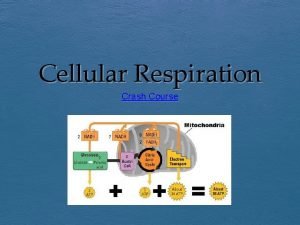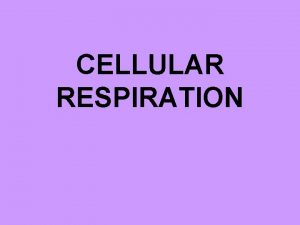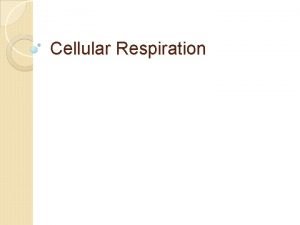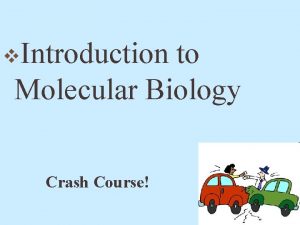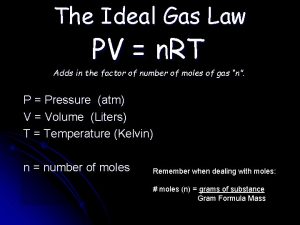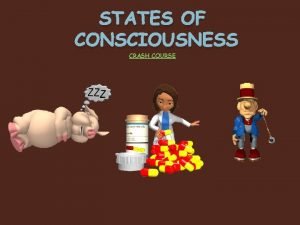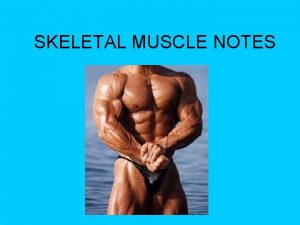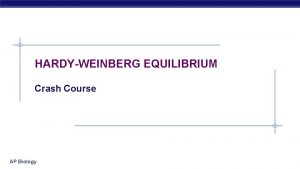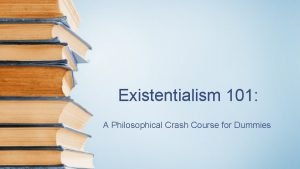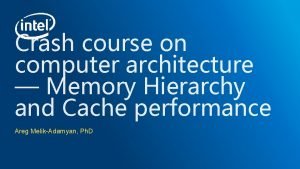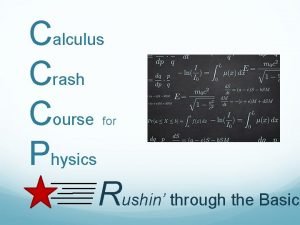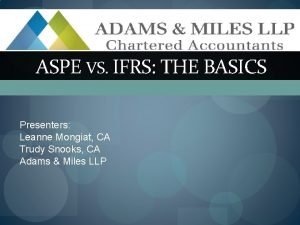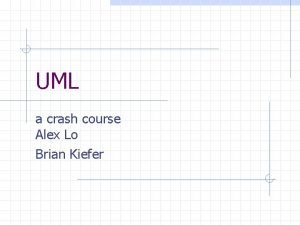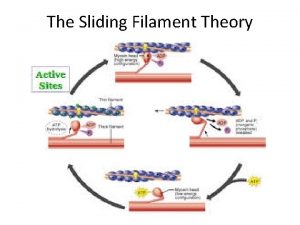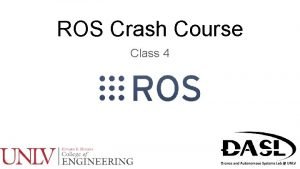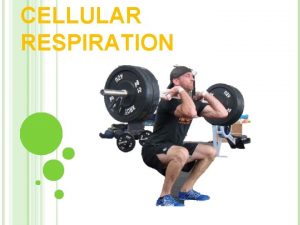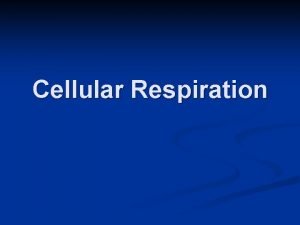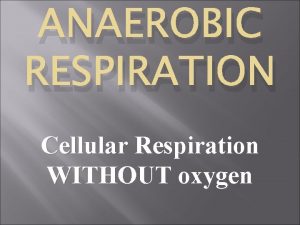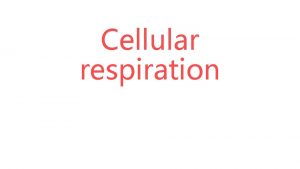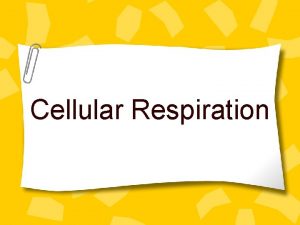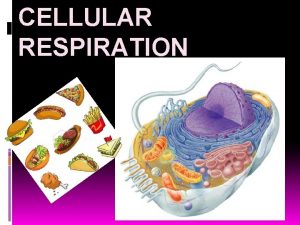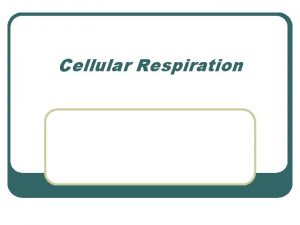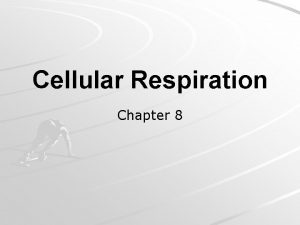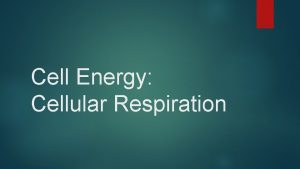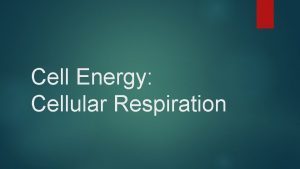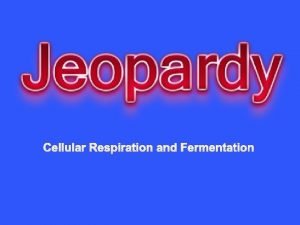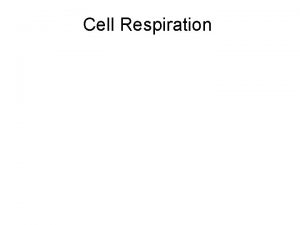Cellular Respiration Crash Course Define cellular respiration Cell



























- Slides: 27

Cellular Respiration Crash Course

Define cellular respiration Cell respiration is the controlled release of energy from organic compounds in cells to form ATP Covalent bonds are slowly oxidized by enzymes releasing ATP molecules Takes place in the presence or in absence of oxygen

Know These Numbers

Glycolysis glucose + 2 ATP 2 pyruvate + 4 ATP + 2 NADPH The breakdown of one molecule of glucose into two molecules of pyruvate with the release of some energy Takes place in the cytoplasm Does not require oxygen Glycolysis Video

Alcoholic Fermentation Done when no oxygen is present Starts with glycolysis The pyruvate is then broken down further Yeast turn the pyruvate into ethanol and carbon dioxide Used to make bread and alcohol

Lactic Acid Fermentation Cell that normally do aerobic respiration can perform fermentation Done when you sprint and the body can not supply the muscles with enough oxygen to perform aerobic respiration Can cause muscle cramps

Aerobic cellular respiration In the presence of oxygen pyruvate is broken down in the mitochondria into carbon dioxide and water This is the most efficient use of this molecule to harvest energy Reaction takes place in the mitochondria Yields approximately 28 -34 more ATP

HL Cell Respiration

Oxidation and Reduction Redox (reduction – oxidation) reaction: the enzyme controlled transfer of electrons Oxidation Is the Loss of electrons Involves gaining an oxygen or losing a hydrogen Energy is lost (exergonic reaction) In respiration glucose is oxidised to carbon dioxide Reduction Is the Gain of electrons All hydrogens are gradually removed from the glucose molecule Involves losing oxygen or gaining hydrogen Energy is absorbed (endergonic reaction) This substance now has the power to reduce other substances and become oxidised in the process In respiration oxygen is reduced to water Remember it by the saying OIL RIG

Oxidation Reduction Loss of electrons Gain of oxygen Loss of hydrogen Gain of hydrogen Results in many C-O bonds Results in many C-H bonds Result is a compound with low potential (stored) energy Result is compound with high potential (stored) energy

Glycolysis Linear series of reactions in which glucose is broken down into 2 molecules of pyruvate Glycolysis takes place in the cytoplasm Glucose + 2 ADP + 2 Pi + 2 NAD+ 2 H 20 2 Pyruvate + 2 ATP + 2 NADH + 2 H+ + Anaerobic process that does not require oxygen Glycolysis takes a 6 -carbon hexose sugar and created 2 3 -carbon monosaccharides The first step is phosphorylation ATP is used to add a phosphate group to the glucose A second phosphorylation using another ATP follows adding a second phosphate This creates fructose biphosphate 2 molecules of ATP are consumed for every molecule of glucose at this point

Glycolysis Cont. • The second step is lysis o • The third step is oxidation o o o • The above chemicals are then involved in a combined oxidation phosphorylation reaction Hydrogen is removed from the triose phosphates NAD acts as the hydrogen receptor The last step is ATP formation o • Fructose biphosphate is split producing 2 triose phosphate molecules each with 3 carbons Lastly the triose biphosphate gives up one of the phosphates to ADP to make it ATP and producing pyruvate Total ATP production for each glucose molecule is 4 but the NET gain is only 2 o Remember we spent 2 ATP at the beginning to start the process


Electron Micrograph of a Mitochondria

Micrograph Explained Found in the cytoplasm of all Eukaryotic cells, usually in large numbers Large organelle surrounded by an outer membrane and an inner membrane Inner membrane is folded – cristae Between the inner membrane and the outer membrane is the matrix Inside is a watery fluid containing enzymes and molecules There also ribosomes and DNA The DNA is maternal DNA and can be used to trace heredity


Structure and Function Structure Function / Role External Double Membrane Permeable to pyruvate, CO 2, O 2 and NAD/NADH Matrix Site of enzymes of link reaction and Krebs cycle Inner Membrane Surface area greatly increased by in tucking to form cristae (increases surface area for electron chain), impermeable to hydrogen ions (allows for a concentration gradient to be created Inter-membrane Space Relatively tiny space, allows the accumulation of hydrogen atoms , facilitates phosphorylation

Aerobic Respiration Link Reaction Forms the link between glycolysis and the Krebs cycle Pyruvate is transferred from the cytoplasm to the mitochondrial matrix Pyruvate + Co. A + NAD+ This reaction is known as decaboxylation of pyruvate Acetyl Co. A + CO 2 + NADH + H+ A carbon dioxide is removed The molecule is also oxidised by the removal of a hydrogen NAD is formed at this time

Aerobic Respiration Krebs Cycle Also known as tricarboxylic citric acid cycle or TCA cycle Occurs in the matrix of the mitochondria 1 molecule of acetyl Co. A yields 2 CO 2 3 NADH + 3 H+ 1 FADH 2 1 ATP

Krebs Cycle Details Acetyl Co. A combines with a 4 -carbon compound to create a 6 carbon compound This compound is then decarboxylated A CO 2 is removed 5 -carbon compound is created The 5 -carbon compound is decarboxylated A CO 2 is removed 4 -carbon compound is created This takes us back the original 4 -carbon compound that starts the cycle The main outputs are energy freed from the compounds

Krebs Cycle Important Notes per molecule that enters Two molecules of carbon dioxide are given off in separate decaboxylation reactions One molecule of ATP is formed Three molecules of NADH (aka reduced NAD) are formed One molecule of FADH (aka reduced FAD) is formed

Summary to this Point Step CO 2 ATP NADH FADH Glycolysis 0 2 2 0 Link Reaction 2 0 Krebs Cycle 4 2 6 2 Totals 6 CO 2 4 ATP 10 NADH 2 FADH

Terminal Oxidation and oxidative phosphorylation A. K. A. – the electron transport chain The removal of H+ from NADH and FADH Releases energy that is transferred to ADP to form ATP End receiver of the H+ is O 2 and this forms water For every molecule of NADH that is reduced – 3 ATP are formed Total yield from aerobic respiration is 38 ATPs

Phosphorylation by Chemiosmosis The synthesis of ATP is coupled to electron transport via the movement of protons Electron –carrier proteins are arranged in the inner mitochondrial membrane Oxidize the reduced coenzymes Energy from the oxidation is used to pump hydrogen ions from the matrix into the space between the inner and outer membranes of the mitochondria A gradient forms generating a potential difference across the membrane – a store of potential energy Hydrogens flow back across the membrane through ATP synthesis enzymes (ATPase) Follow the concentration gradient from high hydrogen to low hydrogen Energy is transferred to ATP

Role in Fat Metabolism Your body can plug other things into the Krebs cycle to generate energy including Starch Glycerol Fatty acids Amino acids Plants can also add cellulose to this list Explains why fats are considered to be energy sources to the body

Cheesy Songs Song 1 Song 2

Bozeman We love bozeman
 Cellular respiration crash course
Cellular respiration crash course All cells must contain
All cells must contain Where in the cell does cellular respiration occur
Where in the cell does cellular respiration occur Where in the cell does cellular respiration occur
Where in the cell does cellular respiration occur Crash course molecular biology
Crash course molecular biology Unity over the shoulder camera
Unity over the shoulder camera Gas laws crash course
Gas laws crash course The crusades crash course
The crusades crash course Cold war crash course
Cold war crash course Consciousness crash course
Consciousness crash course Social psychology crash course
Social psychology crash course Twizzler muscle model
Twizzler muscle model Traversy media react crash course
Traversy media react crash course Project management crash course
Project management crash course Organic chemistry meth eth prop but
Organic chemistry meth eth prop but Hardy weinberg crash course
Hardy weinberg crash course Existentialism crash course philosophy #16 transcript
Existentialism crash course philosophy #16 transcript Computer architecture crash course
Computer architecture crash course Crash course cardiovascular system
Crash course cardiovascular system Calculus crash course
Calculus crash course Ifrs crash course
Ifrs crash course Robotics crash course
Robotics crash course Crash course wwi
Crash course wwi Uml crash course
Uml crash course Crash course sliding filament theory
Crash course sliding filament theory Data mining crash course
Data mining crash course Httpyoutube
Httpyoutube Ros crash course
Ros crash course
